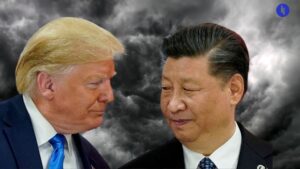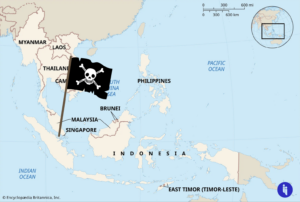The weather’s getting unbearably hot, and we’re getting targeted with ads urging us to seize a limited 345% discount to nab that rubber chicken handbag and pack of bacon bandages you’ve always wanted. It can only mean one thing: Amazon Prime Day is here.
For those unfamiliar, it’s like Black Friday for the world’s biggest e-commerce platform. But this year it’s running for four days and is expected to make Amazon $13B in the US.
So where’s the Intrigue? All the war and rumours of war gazumped our tell-all piece on the Bezos-Sanchez nuptials last week, so we’re now playing catch up. And… whatever happens with one of America’s ‘Magnificent 7’ tech giants has instant global relevance.
Stay on top of your world from inside your inbox.
Subscribe for free today and receive way much more insights.
Trusted by 142,000+ subscribers
No spam. No noise. Unsubscribe any time.
But why Amazon?
- It’s doing ~$650B in sales, making it bigger than Sweden, Singapore, or the UAE
- It operates and delivers in more than 70 countries, making it bigger than the International Committee of the Red Cross, and
- It’s enriched founder Jeff Bezos so much, he not only had (say) the Queen of Jordan at his wedding, but also got to develop some of the world’s most ripped biceps, offering hope for bespectacled and malnourished nerds everywhere.
So yeah, we’ve got our reasons. But let’s quickly cannonball into three of them:
- The canary in the e-coal mine
We keep getting mixed data around what’s happening in the US economy: the S&P500 has now recovered from its Liberation Day crashes, hitting record new highs. And while consumer sentiment dropped in May, it duly bounced back in June. But other data sources suggest most US consumers still say tariffs are shaping their shopping habits.
And it’s not just consumers: some US businesses relying on manufacturing in (say) China and Vietnam are scaling back their Prime Day discounts as tariffs eat their margins, whether on tote bags, ice trays, or skateboards. So the world will be watching Amazon’s Prime Day data for a feel of what’s really going on.
- 4D supply chains
Amazon has never been shy about its global ambitions: with an internal motto of “make history”, it’s long hustled to embed itself into global supply chains. And sure, that goes to its whole schtick: promising third-party sellers (60% of its sales) access to a global market, while promising customers the absolute best darn Nicholas Cage pillowcases money can buy. It’s a network effect you get via scale.
But you get that scale via some big investments: for example, Amazon gets you that sweet sweet same-day delivery on lobster flip-flops thanks in part to its own internal cargo airline operating 95 jets, making it bigger than JetBlue. Ditto, as governments pull up their drawbridges, Amazon is building more local warehouses to minimise its tariffs.
And that’s all made the US giant both less exposed to global shocks (redundancy), but somehow also kinda more exposed (the e-canary above), with any downturn quickly entering its vast global e-commerce arteries, offering a critical heads-up to everyone else. Which leads us to…
- Local pushback
It’s not all rainbow tortilla blankets and butterfly pet costumes for Amazon: just about anywhere this giant treads, it faces claims it’s undercutting local retailers, not paying enough tax, or only able to keep prices on its keyboard waffle irons so low because factory and warehouse workers are getting screwed along the way.
So its sheer ubiquity and profile means other boardrooms are (or should be) watching how governments around the world grapple with Amazon, as that tends to be a reliable straw in the wind for how our world is going about balancing everything else.
Intrigue’s Take
We often say tech is a globalising force in a deglobalising world, and it’s hard to think of a better example than Amazon, which rode the globalisation wave better and more lucratively than just about anyone else. The question now will be whether it can also adapt and stay ahead better than everyone else, and its strategy seems to include aggressive localisation so countries and communities feel they get a stake in the company’s success.
But while we’ve thoroughly amused ourselves focusing above on Amazon’s same-day yodeling pickles and angry mama microwave cleaners, there are some way bigger trends now playing out, as Amazon keeps pushing into data centres, entertainment, self-driving cars, satellite internet, AI, and beyond.
Aside from the specific global significance of each new tech and cultural domain it enters, there’s the unifying significance of how the expanding tech and cultural footprint of a single corporate entity shapes our world ahead. If you’ve read the work by sci-fi guru William Gibson, you’ll have seen his vision for where this ends up: he paints a future where (for example) Gucci ends up selling high-end military gear, Adidas sells surveillance kit, Sun Microsystems makes virtual celebrities, Boeing makes private space stations, IBM gets into construction, and Kodak controls influential new forms of art.
It’s fiction, of course, and we don’t seek to pick on Amazon or question its historic innovations over the years. Rather, it offers a hint at how these continued sectoral expansions might blur any lines between commerce, culture, tech, and even politics, shaping our world in ways that leave even elected governments looking a little quaint.
Sound even smarter:
- Initial reports suggest Prime Day sales might be ~14% down on last year.
- A regulatory filing shows Jeff Bezos just sold Amazon shares worth $665M, as part of a plan he announced earlier this year.








